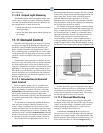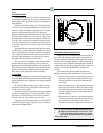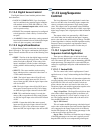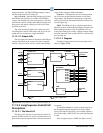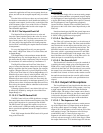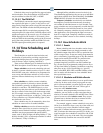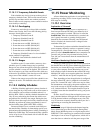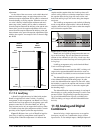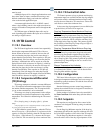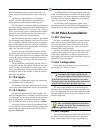
Time Scheduling and Holidays Software Overview • 11-43
If desired, delays may be specified for stage activation
and deactivation. Also, the definitions of OFF and ON
may be redefined as either ON, OFF, or NONE.
11.13.3.2 The PWM Cell
The PWM cell converts the control output percentage
into a periodic ON pulse. A “pulse” in this cell is a con
-
stant period of time that consists of one ON event and one
OFF event. The PWM cell takes the PID percentage and
turns the output ON for an equivalent percentage of the
total pulse period. In other words, if the PID output is 60%
and the pulse period is 30 seconds, every 30 seconds the
PWM output will be ON for 60% of 30 seconds (18 sec
-
onds) and OFF for the remaining portion of the 30-second
period. Once the period has ended, the PWM Cell reads
the PID output again and the process is repeated.
11.14 Time Scheduling and
Holidays
Time Schedules are used for timed activation and
deactivation of loads and for providing occupied and
unoccupied building times for occupancy-driven systems
(such as Sensor Control, Lighting, and HVAC).
There are four different types of schedules used by the
E2. Brief description of each of these are given below:
Master schedules are the main scheduling unit used
by the E2. A master schedule consists of up to 15 sched
-
uled ON/OFF event pairs, which may be programmed to
occur on any individual date and time or series of dates
and times. Master schedules may also drive slave sched
-
ules.
Slave schedules are similar to master schedules,
except their operation is driven by a master schedule.
Slave schedules, generally, are alterations of the master
schedule’s event times. The ON/OFF times in a slave
schedule may take place either at specific defined times of
the day or relative to the times given in the master sched
-
ule. For example, a master schedule may say: “The build-
ing is occupied from 8:00 a.m. to 9:00 p.m.” while one of
its slave schedules says “Dim the building lights 15 min
-
utes before the store closes.”
Slave schedules may also be mastered by other slave
schedules to create a series of stacked schedules.
Holiday schedules are used to tell master and slave
schedules that a special day or event is occurring. For
example, master schedules and their corresponding slave
schedules may be programmed with special holiday
events, such as “Keep all lights off during Holiday x.” The
holiday schedule’s job is to inform the schedules to which
it is connected, “Today is Holiday x.”
Although holiday schedules are used exclusively by
Time Scheduling applications, they are set up as individual
applications separate from Time Scheduling. See
Section
11.14.2, Holiday Schedules for more information.
Temporary schedules are technically not schedules
but temporary override functions that may be made to
exist within an individual master or slave schedule. Tem
-
porary schedules are used to temporarily override the ON/
OFF instructions of an individual master or slave sched
-
ule. Generally, temporary schedules are only used for one-
shot applications, such as keeping the lights on an extra
hour for a single night. Temporary schedules override all
other events within a master or slave schedule, including
holidays.
11.14.1 How Schedules Work
11.14.1.1 Events
Master schedules and slave schedules consist of up to
15 pairs of events. Events are simple commands to turn
the schedule output either ON or OFF at a particular time
within a range of days. Events are usually programmed in
pairs, so that during a specified range of days the schedule
output can be turned ON and OFF at a particular time
within the same day. However, events may be pro
-
grammed singularly (on OFF or one ON command per
day). Events may be programmed to take place on any or
all days from Sunday to Saturday. In addition, events may
take place on any or all of four holiday (or “special”)
dates, called HD1, HD2, HD3, and HD4. Holiday sched
-
ules are used to tell the master or slave schedules when
these special dates occur.
11.14.1.2 Absolute and Relative Events
Master schedule events always occur at specific times
of the day. In other words, when you program an event
pair in a master schedule, you must specify two specific
times of the day the events will occur. These types of
events are called absolute events.
However, when programming event times in slave
schedules, you may choose to enter event times that are
relative to its master schedule’s ON and OFF times. These
types of events are called relative events. They are pro
-
grammed not as absolute times but as amounts of time
before or after its master schedule’s events.
For example, suppose a master schedule is set up to be
ON at 8 a.m. and OFF at 9 p.m. every day of the week, and
you wish to set up a slave schedule so that its output
comes ON 15 minutes before the master comes ON and
OFF 15 minutes after the master goes OFF. To do this, you
would set up the slave schedule to come ON at -00:15 and
OFF at +00:15 every day of the week. The slave schedule
will automatically determine the correct ON and OFF
times.



